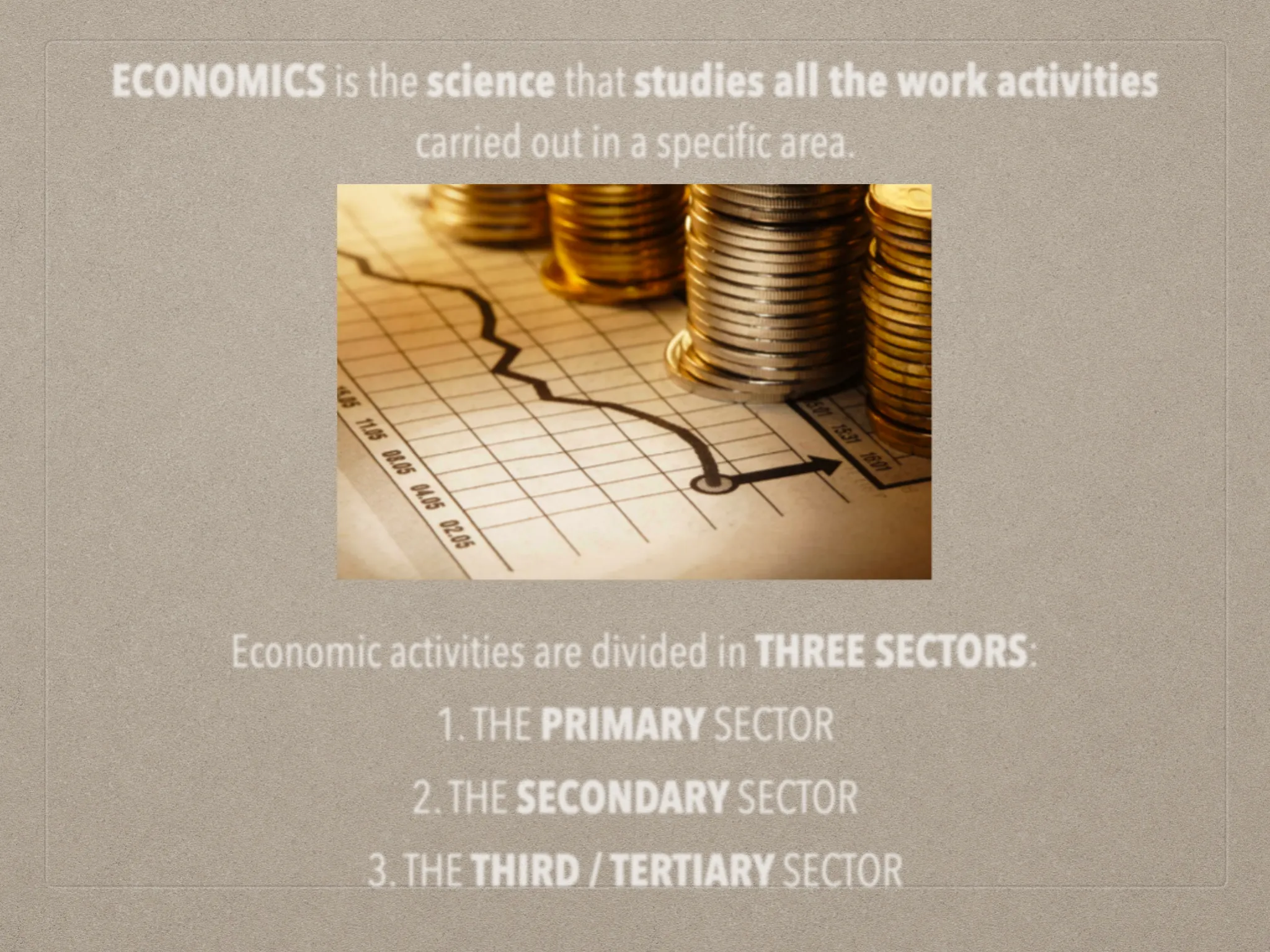The Sectors of Economy: Primary, Secondary, and Tertiary Activities
Slides about The Sectors of Economy. The Pdf provides a clear explanation of economic activities, divided into primary, secondary, and tertiary sectors, with examples and illustrations. This material is suitable for high school students studying Economics.
See more17 Pages


Unlock the full PDF for free
Sign up to get full access to the document and start transforming it with AI.
Preview
The Sectors of Economy
ECONOMICS is the science that studies all the work activities carried out in a specific area.
505 11.05 08.05 04.05 02.05 5501 15:31 16:01
Economic activities are divided in THREE SECTORS:
- THE PRIMARY SECTOR
- THE SECONDARY SECTOR
- THE THIRD / TERTIARY SECTOR
Economy Sectors
ACTIVE PUBLIC PASSIVE PUBLIC JOBS Happy Learning
The Primary Sector
1.THE PRIMARY SECTOR: includes activities linked to the GATHERING OF RAW MATERIALS OR NATURAL RESOURCES:
- The SOIL through agriculture
- ANIMALS through farming, fishing and aquaculture.
- The FORESTS/WOODS through forestry.
- The UNDERGROUND through mining.
Primary Sector Activities
Primary sector PRIMARY SECTOR Happy Learning
Activities of the Primary Sector
1. The activities of the primary sector
Agriculture Is the economic activity related to the cultivation of the soil. Today, the increasing use of machinery and innovative techniques has decreased the number of workers in agriculture.
Aquaculture Is the economic activity linked to the farming of fish and shellfish (mussels, clams, oysters). It is carried out in large pools of fresh water or equipped sections of sea near the coasts.
Mining It concerns the extraction of mineral resources from the subsoil and seabed. Many of these resources can be used as a source of energy.
Farming Is the economic activity of getting food products (milk, eggs, cheese, leather, etc.) from the use of animals.
Fishing Is an economic activity that is mainly carried out at sea, where fishing boats catch large quantities of fish. It is also carried out in lakes and rivers.
Forestry Is the activity of obtaining wood and other resources found in forests, such as mushrooms, truffles and chestnuts.
The Secondary Sector
2.THE SECONDARY SECTOR: includes the TRANSFORMATION OF PRIMARY RESOURCES INTO ELABORATED PRODUCTS It includes both INDUSTRIAL PROCESSING (products that are the same as each other, in series) and CRAFTWORK (different products in limited quantities)
There are THREE TYPES OF INDUSTRIES:
- BASIC INDUSTRIES (producing semi-finished products for further processing).
- MANUFACTURING INDUSTRIES (which produce finished products)
- TECHNOLOGICALLY ADVANCED INDUSTRIES (high tech)
C61
Secondary Sector Activities
Secondary sector SECONDARY SECTOR Happy Learning
Activities of the Secondary Sector
2. The activities of the secondary sector
Chemical sector Chemicals are made by basic industries when they are destined for later transformation. The production of finished objects, such as those made of plastics, belongs to manufacturing.
Steel and metallurgical industries 53 They belong to the basic industry. They concern the manufacture of semi- finished metal products and steel sheets.
Energy sector They belong to the basic industry. Includes oil refineries, power stations and many other centers for producing forms of energy.
Agribusiness sector It belongs to the manufacturing industry. Uses agricultural or farming products to preserve or transform them into food goods, for example, cheeses.
Textile and clothing industry It belongs to the manufacturing industry. Concerns the production of textiles and clothing.
Editorial graphic department It belongs to the manufacturing industry. It turns the creatives ideas into finished products such as books, newspapers, television programs.
Building industry It belongs to the manufacturing industry. It concerns the construction of buildings, roads and other facilities for people.
Engineering industry It belongs to the manufacturing industry. It concerns the production of cars and other means of transportation, household appliances.
Electronics industry They belong to the high tech industry. They concern the production of computers, telephones and other devices.
The Tertiary Sector
3.THE TERTIARY SECTOR: includes all the ACTIVITIES THAT PROVIDE SERVICES to satisfy people's needs
Activities financed and managed by the State are part of the PUBLIC SECTOR. Activities managed by private citizens are part of the PRIVATE SECTOR.
---- ntv
Tertiary Sector Activities
Tertiary sector TERTIARY SECTOR dapny Learning
Activities of the Tertiary Sector
3. The activities of the tertiary sector
Welfare Includes medical care from birth throughout life. Some examples are clinical examinations, medical treatment, hospitalization, and surgery.
Transportation Today it enables people and goods to reach any place on Earth. Long- distance transportation is increasingly being upgraded to make it faster.
Scientific research It takes place in public and private research centers. It is one of the most important areas for economic growth and improving the quality of life.
Banking and financial activities 251AT 182NT 2534T 255MT TRY 1721 ASTE/T 4542VT 4592PT 4002VT A630'T 4990FT 4700T NY 2015 +254 1000 125 1925'T 1345/T 1872IT 1639 ND 2728 3421 ARANT These are the activities involve managing and investing money. The importance of financial activities is growing rapidly.
Education Obligatory education of young people and higher education are essential for human and economic growth.
Tourism It supports transportation, hotel and restaurant businesses, many jobs such as tour guide and other.
Retail Today, trades are carried out in multiple ways through stores, supermarkets, shopping malls and various forms of online retail.
Computer services ON 2 They concern assistance to companies and individuals in the use of information technology tools.
Economic Activity Sector Classification
Choose what sector each economic activity/job belongs to.
01. Fishing A. Primary sector B. Secondary sector C. Tertiary sector
02. A. Primary sector B. Secondary sector C. Tertiary sector Mining
03. Clothing factory A. Primary sector B. Secondary sector C. Tertiary sector
04. A. Primary sector B. Secondary sector C. Tertiary sector Office
05. A. Primary sector B. Secondary sector C. Tertiary sector Car factory
Gross Domestic Product (GDP)
GDP indicates the money value of goods and services produced in a State in a year. This value is usually expressed in U.S. dollars. If a country's GDP has grown from the previous year, the economic performance in that country is considered positive. In general, European states have higher GDPs compared to those on other continents.
The Wealth of States - Per Capita Income (PCI)
IL PIL per abitante fa comprendere meglio la condizione economica di uno Stato Il calcolo del PIL non basta per valutare se la popolazione di uno Stato dispone di una ricchezza limitata oppure ele- vata, grazie alle attività economiche. È infatti necessario sapere anche tra quanti abitanti va divisa la ricchezza prodotta. Per questo occorre conoscere il numero degli abitanti di quello Stato. Gli economisti dividono il valore del PIL per il numero degli abitanti. Utilizzano, in questo modo, un indicatore chiamato PIL per abitante (PIL/ab.) o PIL pro capite (espressione latina che significa «a persona»). Il PIL per abitante si ottiene dividendo il PIL di uno Stato per il numero dei suoi abitanti. Da esso ricaviamo il reddi- to medio di ciascun cittadino 1, cioè la sua condizio- ne economica. Questo dato è solo una media aritmetica, cioè divide la ricchezza complessiva dello Stato in parti uguali tra tutti gli abitanti, mentre la ricchezza di un Paese non è divisa in parti uguali, ma ci sono i ricchi e i poveri.
GDP Per Capita in Europe
1 || PIL/ab. dell'Europa LEGENDA ISLANDA Oltre 90.000 dollari Da 40.000 a 90.000 dollari Da 20.000 a 40.000 dollari FINLANDIA Da 5000 a 20.000 dollari { NORVEGIA SVEZIA Meno di 5000 dollari REGNO ESTONIA UNITO LETTONIA DANIMARCA RUSSIA IRLANDA LITUANIA PAESI BASSI BIELORUSSIA BELGIO GERMANIA POLONIA LUSSEMBURGO REP. CECA UCRAINA SLOVACCHIA FRANCIA AUSTRIA UNGHERIA MOLDAVIA SVIZZERA SLOVENIA CROAZIA ROMANIA BOSNIA- SERBIA PORTOGALLO ERZEGOVINA MONTENEGROKOSOVO SPAGNA ITALIA ALBANIA GRECIA. MALTA CIPRO https://www.google.com/publicdata/explore?ds=d5bncppjof8f9_&hl=it&dl=it#! ctype=l&strail=false&bcs=d&nselm=h&met y=ny gdp_pcap_cd&scale_y=lin&ind y =false&rdim=world&idim=country:ITA:FRA&ifdim=world&hl=it&dl=it&ind=false ANDORRA BULGARIA MACEDONIA
Human Development Index (HDI)
L'ISU descrive la qualità della vita di una popolazione Anche il PIL per abitante non è sufficiente a chiarire l'ef- fettiva condizione di vita degli abitanti di uno Stato per- ché indica soltanto il valore medio della produzione eco- nomica di un Paese. Perciò l'Organizzazione delle Nazioni Unite (ONU) ha introdotto un nuovo indicatore che si chiama Indi- ce di Sviluppo Umano (ISU) 2. L'ISU tiene conto, oltre che del PIL per abitante, anche di altri due fattori: · la speranza di vita alla nascita (
HDI in Europe
2 L'ISU dell'Europa LEGENDA ISLANDA Oltre 0,900 Da 0,850 a 0,899 Da 0,800 a 0,849 FINLANDIA Da 0,750 a 0,799 Y NORVEGIA SVEZIA Meno di 0,749 ESTONIA REGNO KUNITO LETTONIA DANIMARCA RUSSIA IRLANDA LITUANIA PAESI BASSI BIELORUSSIA BELGIO GERMANIA POLONIA LUSSEMBURGO REP. CECA UCRAINA FRANCIA AUSTRIA UNGHERIA MOLDAVIA SVIZZERA SLOVENIA CROAZIA ROMANIA BOSNIA- SERBIA PORTOGALLO ERZEGOVINA BULGARIA SPAGNA ITALIA MACEDONIA ALBANIA GRECIA. MALTA CIPRO SLOVACCHIA ANDORRA MONTENEGRO KOSOVO
Wealth of States - HDI Data
LA RICCHEZZA DEGLI STATI - L'ISU
| Posizione | ISU 2020, dati del 2019 [1] | Cambiamento rispetto a cinque anni prima[1] | Nazione | 2020, dati del 2019 [1] | Cambiamento medio nel periodo 2010- 2019 [1] | |||||
| 1 | - | Norvegia | 0,957 | 0,20% | 16 | Y-1 | I+I Canada | 0,929 | 0,34% | |
| 2 | A 7 | Irlanda | 0,955 | 0,65% | 17 | V-3 | Stati Uniti | 0,926 | A 0,12% | |
| 2 | - | + | Svizzera | 0,955 | A 0,16% | 18 | - | Austria | 0,922 | A 0,22% |
| 4 | A 7 | Hong Kong | 0,949 | A 0,54% | 19 | A 1 | Israele | 0,919 | A 0,29% | |
| 4 | A 4 | H | Islanda | 0,949 | 0,62% | 19 | A 2 | Giappone | 0,919 | A 0,39% |
| 6 | Y-3 | Germania | 0,947 | A 0,24% | 19 | - | Liechtenstein | 0,919 | 0,18% | |
| 7 | Y-3 | Svezia | 0,945 | A 0,41% | 22 | A 2 | Slovenia | 0,917 | A 0,35% | |
| 8 | Y-2 | Australia | 0,944 | 0,17% | 23 | Y-1 | Corea del Sud | 0,916 | 0,33% | |
| 8 | Y-1 | Paesi Bassi | 0,944 | A 0,32% | 23 | Lussemburgo | 0,916 | 1 0,22% | ||
| 10 | V-6 | Danimarca | 0,940 | A 0,28% | 25 | A 1 | Spagna | 0,904 | A 0,40% | |
| 11 | Y-2 | + Finland | 0,938 | A 0,26% | 26 | Y-1 | Francia | 0,901 | A 0,28% | |
| 11 | - | Singapore | 0,938 | A 0,35% | 27 | Y-1 | Rep. Ceca | 0,900 | A 0,38% | |
| 13 | == Regno Unito | 0,932 | 1 0,24% | 28 | A 2 | Malta | 0,895 | A 0,54% | ||
| 14 | A 1 | Belgio | 0,931 | A 0,25% | 29 | A 2 | Estonia | 0,892 | 0,51% | |
| 14 | A 3 | Nuova Zelanda | 0,931 | 0,30% | 29 | Y-1 | Italia | 0,892 | A 0,16% |